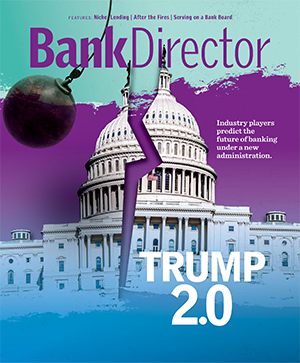
Rebranding the Bank: One Bank’s Transformation

A need to grow, coupled with brand confusion in the market, drove the transformation in late 2012 of Kaiser Federal Bank to Simplicity Bank, a savings bank with $855 million in assets headquartered in Covina, California. Simplicity operated as Kaiser Permanente Federal Credit Union from its founding in 1953 until 1999, when it converted to a savings bank and changed its name to Kaiser Federal Bank. In the more than a decade since that conversion, many potential customers still thought the institution was a credit union, with membership limited to Kaiser Permanente employees and families. The bank’s name was no longer relevant. “Nobody thought we were an option,” says Simplicity President and CEO Dustin Luton. “If we wanted to be able to make inroads in the community, then we knew we needed to do something with the name.”
The Solution
Tim Pannell, president and CEO of Financial Marketing Solutions, a Franklin, Tennessee-based marketing firm, says that Simplicity Bank’s story highlights how a rebrand’s success is directly tied to the commitment of the institution’s management and board. “They had full support from the top down and they all understood what they were doing,” he says. While it’s too early to measure rebranding’s impact, Luton sees more interest in the bank within his market as well as a more focused culture at the bank. “It definitely strengthens the mission and the objective of the organization,” he says.
So when should the bank consider a rebrand? Simplicity’s shift from a credit union to a bank charter is just one example. Pannell says expansion into a new market, whether through acquisition or organic growth, could create a need to rebrand, especially if your name evokes a certain geographic location that might not be relevant to other markets. Rethinking the bank’s brand could also come down to a change in strategic direction, perhaps through a change in management or a perceived need to shift corporate goals to remain relevant in the marketplace.
Here are four points to consider if you are rebranding the bank.
Answer the question: Who are you?
A brand initiative is not an advertising campaign, says Pannell. Ideally, a brand should describe what the organization is about, both for customers and employees. When it came time to consider a new name at Simplicity, Financial Marketing Solutions met with the board and management and conducted focus groups with customers, potential customers and employees to look into these groups’ perceptions of the bank’s brand. Luton says the new name needed to align with how the bank was already doing business—making life simple for its customers and building a strong employee culture around that goal.
The new brand “needed to be something that we felt the organization could live and breathe and execute,” he says. Part of making life simple for the customer includes investment in streamlined technology and self-help options so the bank can be available when needed. The bank is trying to identify points where a customer has to call or visit the bank, perhaps to stop payment on a check, and build that option into online and mobile banking to give the customer more flexibility. “To be simple, you have to embrace technology,” says Luton.
Create internal brand awareness from the top down.
If bank employees don’t own the brand, then it won’t catch on with customers. That ownership comes from the top down, usually from the CEO, says Pannell. Communicating a consistent brand message to each employee reinforces the brand, with employees championing this message to customers.
Simplicity’s management team continues to focus on communicating the brand message within the bank. “The more employees hear it from me, the more I recognize employees for making banking simpler for customers, the more it becomes ingrained in the philosophy and culture” at Simplicity, Luton says.
And Luton feels that the brand strengthens the institution’s goals by communicating one basic idea—simplicity—to all employees. Expanding mobile and online banking while still maintaining phone and branch channels offers the access and convenience that is key to making the customer’s life easier. “Everybody has the same strategic imperative, from me all the way down to the front line. That’s one of the values of this brand for us,” he says.
Don’t forget the bank’s existing customers.
Simplicity originally planned to focus its marketing budget on attracting new customers within the market, but scaled back those plans to also explain the merits of the new brand to existing customers. “The greatest opportunity for most banks to grow and increase profitability is within their existing customer base,” says Pannell. The return on investment for deepening the relationship with current customers is typically greater than that of attracting new business, and encouraging adoption of mobile banking and online services like bill payment is a great way to retain customers, according to Pannell.
Be patient. Building brand awareness takes time.
“Brands aren’t built in a year,” says Luton. “Don’t think that you’re going to change the name and all of the sudden everybody’s going to start showing up.” He expects growth to take place over several years as awareness of the brand builds within the market.
“When you think about rebranding, you must always think about long-term vision and goals, not short term,” Pannell says. “It’s really about a 3-, 5-, 7-year vision of where this organization is moving.”



